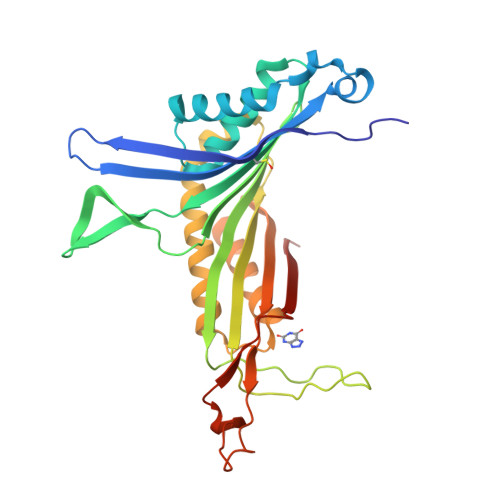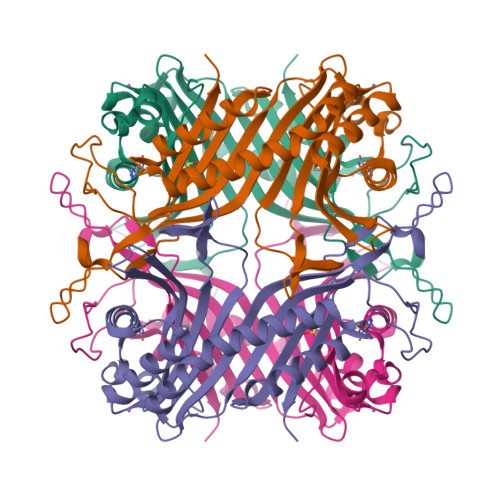Joint neutron/X-ray crystal structure of a mechanistically relevant complex of perdeuterated urate oxidase and simulations provide insight into the hydration step of catalysis.
McGregor, L., Foldes, T., Bui, S., Moulin, M., Coquelle, N., Blakeley, M.P., Rosta, E., Steiner, R.A.(2021) IUCrJ 8: 46-59
- PubMed: 33520242
- DOI: https://doi.org/10.1107/S2052252520013615
- Primary Citation of Related Structures:
7A0L - PubMed Abstract:
Cofactor-independent urate oxidase (UOX) is an ∼137 kDa tetrameric enzyme essential for uric acid (UA) catabolism in many organisms. UA is first oxidized by O 2 to de-hydro-isourate (DHU) via a peroxo intermediate. DHU then undergoes hydration to 5-hy-droxy-isourate (5HIU). At different stages of the reaction both catalytic O 2 and water occupy the 'peroxo hole' above the organic substrate. Here, high-resolution neutron/X-ray crystallographic analysis at room temperature has been integrated with molecular dynamics simulations to investigate the hydration step of the reaction. The joint neutron/X-ray structure of perdeuterated Aspergillus flavus UOX in complex with its 8-azaxanthine (8AZA) inhibitor shows that the catalytic water molecule (W1) is present in the peroxo hole as neutral H 2 O, oriented at 45° with respect to the ligand. It is stabilized by Thr57 and Asn254 on different UOX protomers as well as by an O-H⋯π interaction with 8AZA. The active site Lys10-Thr57 dyad features a charged Lys10-NH 3 + side chain engaged in a strong hydrogen bond with Thr57 OG1 , while the Thr57 OG1-HG1 bond is rotationally dynamic and oriented toward the π system of the ligand, on average. Our analysis offers support for a mechanism in which W1 performs a nucleophilic attack on DHU C5 with Thr57 HG1 central to a Lys10-assisted proton-relay system. Room-temperature crystallography and simulations also reveal conformational heterogeneity for Asn254 that modulates W1 stability in the peroxo hole. This is proposed to be an active mechanism to facilitate W1/O 2 exchange during catalysis.
Organizational Affiliation:
Randall Centre for Cell and Molecular Biophysics, King's College London, London SE1 1UL, United Kingdom.



















